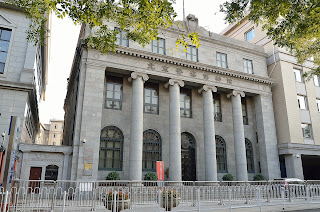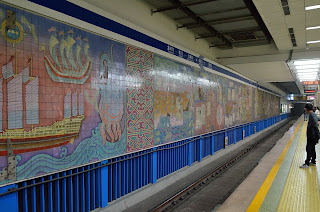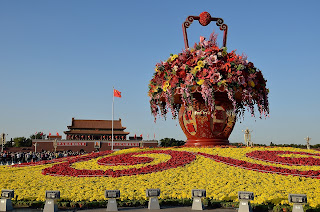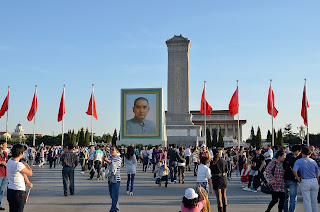
Last weekend Margot and I visited the Lama Temple or Yonghegong in Beijing. The place built in 1694 as a residence for Prince Yong of the Qing Dynasty. After Yong's death his successor converted it into a Tibetan Buddhist monastery.

It is an interesting combination on tourist site and working Buddhist temple.
The site survived the Cultural Revolution (1996-1976) thanks to the personal intervention of Zhou Enlai. During this time period many relics of the Imperial period were destroyed.

Here you can see one of the monks monitoring one of the incense burning vessels.
The streets leading to the temple and even the subway station is crowded with incense vendors.

As I said it is a working temple.
I think the sign is saying don't take pictures inside the hall. But I took it more literally. I can assure you I didn't burn any film in the hall although I did capture a few photons on the CMOS sensor in my camera.

The halls all run together so I'm not sure which on this is.

Apparently Buddha takes many forms.
That is a short fat Buddha above and several more svelte Buddhas here.

I'm sure the hand positions have significance but you will have to explore that on your own.

Sort of hard to see here but there are a series of desks or reading stations in this hall. I gather it must be used for instruction or meditation.

This Buddha is allegedly carved from a single sandlewood tree. The statue is 18 meters above ground and 8 meters below ground.

I find the architecture very interesting.
Notice the bells on many of the eves.

Another shot of the architecture.

This is a smaller hall off to the side.
I thought the grass on the roof was interesting.

I imagine this place was spruced up with a fresh coat of paint for the Olympics 4 years ago. It looks really nice.
There are a number of ginko trees in the compound. I didn't realize they bore fruit.

These are nice - but fake. They appear to be made of painted wood.
There is a small museum inside with a number of artifacts. This is a robe. Margot was impressed by the embroidery.
Ok. These items are made from human skulls. Those are kapala or cups on the top and damaru or drums on the bottom.
Don't believe me? Take a look at the closeup below.
If I read the wikipedia article right one half is a male skull and the other half is a female.
Learn more here --> Damaru or Kapala
Interesting information about the source of skulls and which have the most ritual power. --> Kapala Sources
This is bumpa or ritual vase. Not as exotic as the damaru or kapala.
After we left the temple we walked down a hutong toward the subway station. Here are a number of narrow passage ways off the main alley.
I can never tell exactly here the common property ends and someone's home begins. Depending of the length there may be dozens of homes off these little passageways.















































